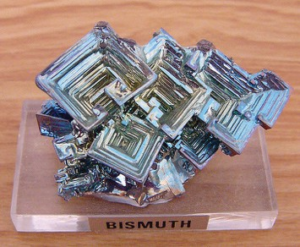Chapter 1. Minerals
Introduction
Have you used a mineral yet today? You might not think so at first, but answer these questions: Have you brushed your teeth? Have you eaten anything containing salt? Did you put on make-up this morning, or do you have painted fingernails or toenails? Have you used a cellphone? What about a car, bike, or public transportation? If you have done any of those things, you have used at least one mineral, and in many cases you have used a great number of minerals. Minerals are very useful and common in everyday products, but most people do not even realize it.
A mineral is a naturally occurring inorganic solid with a definite chemical composition and a characteristic crystalline structure. Naturally occurring means that substance has not been created by humans. The bismuth crystals in Figure 1.1 don’t count as a mineral because they have been created synthetically.

To be an inorganic, the mineral must not be composed of the complex carbon molecules that are characteristic of life. Minerals must be in the solid state, rather than a vapor or liquid. This means that water in its liquid form is not a mineral, but it is a mineral in its solid form, as ice, as long as the ice was not made by humans.
Definite chemical composition refers to the chemical formula of a mineral. For most minerals, this does not vary. The mineral halite, the main ingredient in table salt, always has the composition NaCl. However, some minerals have a range of compositions, because one element can substitute for another of similar size and charge. The formula for the mineral olivine is written as (Mg,Fe)2SiO4 because the magnesium and iron content can vary.
Minerals have a crystalline structure because the atoms within minerals are lined up in an orderly fashion. Characteristic mineral shapes are just the outward manifestation of the mineral’s internal atomic arrangement.
Learning Outcomes
After completing this chapter, you should be able to:
- Define mineral
- Understand the different physical properties of minerals, and how to apply them when identifying a mineral
- Distinguish mineral cleavage from mineral fracture
- Identify 20 common rock-forming minerals
Key Terms
- Cleavage
- Crystal form
- Fracture
- Hardness
- Lustre
- Mineral
- Mineral habit
- Specific Gravity
- Streak
- Tenacity
Attributions
Adapted from:
McBeth, J., Panchuk, K., Prokopiuk, T., Hauber, L., & Lacey, S. (2020). Introductory Physical Geology Laboratory Manual, 1st Canadian Ed., Chapter 2. Minerals by L. Hauber & J. McBeth. CC BY-SA 4.0
Deline, B., Harris. R. & Tefend, K. (2015) Laboratory Manual for Introductory Geology, 1st Edition, Chapter 7. Minerals by R. Harris. CC BY-SA 4.0

